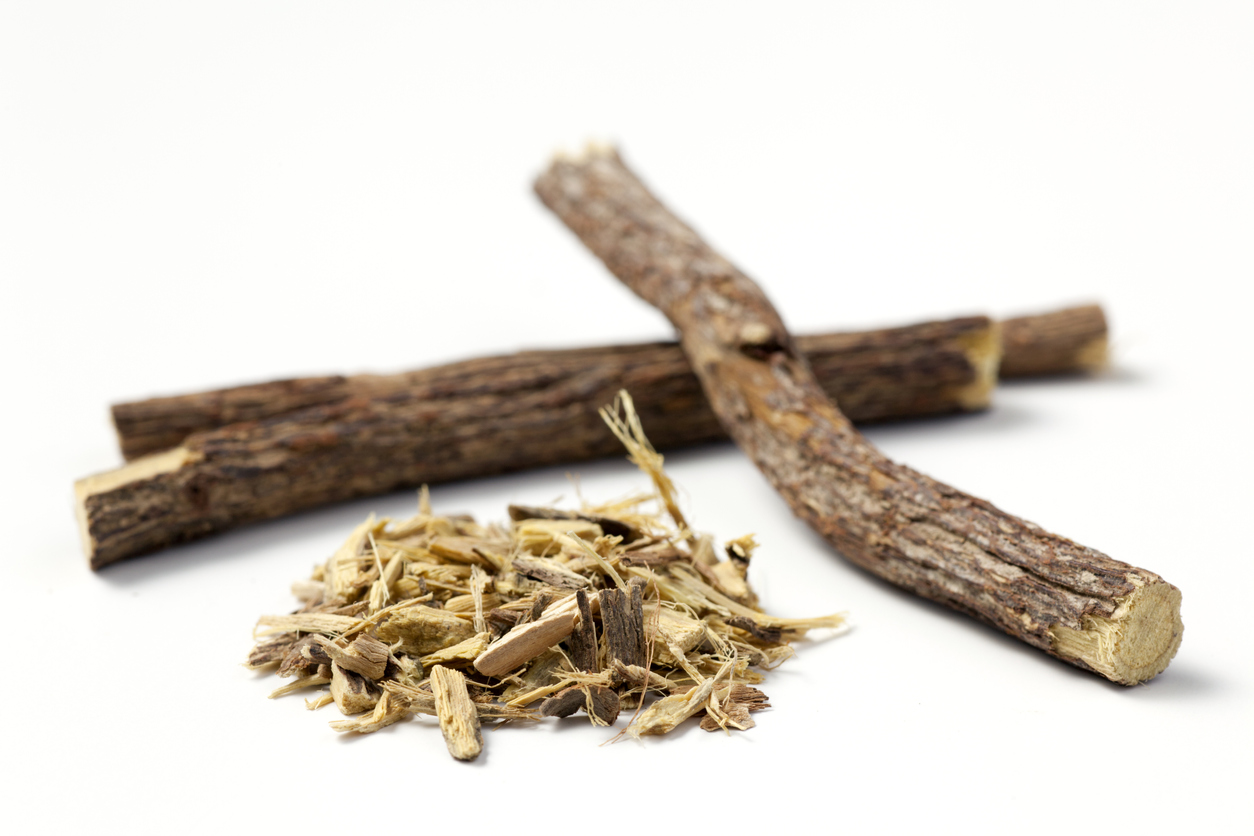
Written by: Dr. Haneefa Willis – Johnson, Western Herbal Dispensary, Assistant Manager
Licorice Root for the use of Gastrointestinal Inflammation
Reactive oxygen species (ROS) are small enzymatic molecules that are produced by cells in the mucosal lining of the intestines as well as activated innate immune cells. ROS enzymes: superoxide (02-), hydroxyl (OH), and hydrogen peroxide (H2O2) are pivotal in fighting infection and wound healing however it is essential that epithelial exposure to ROS is balanced. A breakdown in the antigenic signaling pathway can result in a hyperinflammatory response. A toxic level of ROS production jeopardizes the integrity of the intestinal lining & efficient pathogen removal leading to chronic gastrointestinal (GI) inflammation (Aviello, 2017). In adults (>18 y/o), the occurrences of GI inflammation have risen by 0.9% since 1999 (National Center for Chronic Disease Prevention and Health Promotion, 2019). Conventional treatments include aminosalicylate (5-ASA) drugs, immunomodulatory agents like corticosteroids, and hematopoietic stem cell transplantation from an antigen-matched donor (Aviello, 2017).
Alternatively, Licorice root Glycyrrhiza glabra is a traditional medicinal plant that has exhibited an impressive propensity to combat inflammation activity (Eichenfield, 2007). A major phytoconstituent of Licorice is the bitter-tasting triterpenoid saponin, glycyrrhizin. Numerous therapeutic capabilities of glycyrrhizin have been linked to antiviral, antibacterial, antihepatotoxic, and cytoprotective effects (Murray, 2020, p.642-643). Additionally, evidence-based laboratory research shows that glycyrrhizin also balances the excessive accumulation of neutrophil-mediated ROS (Akamatsu, 1991). Neutrophils are innate immune cells that activate in the presence of an antigen or allergen (Hosoki, 2016). Researchers Akamatsu, Komura, and Niwa (1991) looked at the three main functions of neutrophils (1) mobility to a target, (2) ability to ingest a target, and (3) generation of ROS each in assay systems concentrated with 0.05, 0.5, and 5.0 mg/ml of glycyrrhizin. Akamatsu et al. (1991) found that the presence of glycyrrhizin at any concentration made no impact on the neutrophil’s mobility or phagocytic capacities. However, they found a significant decrease (P <0.05) in the neutrophil-mediated ROS production (O2-, OH, H202) which directly correlated to the glycyrrhizin concentration. The inhibition of neutrophil metabolism of ROS in the presence of glycyrrhizin can reduce the damaging effects seen in chronic gastrointestinal inflammation by limiting a hyperresponsive immune system (Akamatsu, 1991). Together, this finding and the scientific discovery of bitter taste receptors (T2R) in the GI lining clarifies the medicinal benefits observed clinically in a wide variety of cultures that expand thousands of years (Wu, 2002).
This newsletter article is for educational purposes only. It is not a substitute for professional care by a physician or other qualified medical professionals. It is provided on the understanding that it does not constitute medical or other professional advice or services. If you are looking for help in your journey, we recommend you seek out a qualified MUIH herbal practitioner that can personalize herbal formulas specific to your needs. Contact us at (410)888-9048 ext. 6676 or for more information. Licorice root is not for use in persons with hypertension, liver disorders, edema, severe kidney insufficiency, low blood potassium, or heart disease.
MUIH Herbal Dispensary
Interested in purchasing herbs from the Herbal Dispensary at MUIH? The dispensary provides herbal teas, powders, and liquid extracts that are custom compounded to the unique specifications of practitioners who have tailored these products to meet the individual needs of their clients. Email to request an account. Sign into your account here.
Herbal Medicine Programs at MUIH
MUIH’s one of a kind herbal medicine programs recognize and respect the power of nature and herbs in promoting health and wellness, by integrating cultural traditions and contemporary science and research. Graduates support the growing consumer use of herbal medicine in community health and wellness, clinical, research, manufacturing, and retail settings. The Herbal Dispensary at Maryland University of Integrative Health is a unique and valuable resource of the Herbal Medicine academic programs. The dispensary provides the tools and space for students to get hands-on experience creating, formulating, and compounding herbal preparations.
Resources
Akamatsu, H., Komura, J., Asada, Y., & Niwa, Y. (1991). Mechanism of Anti-Inflammatory Action of Glycyrrhizin: Effect on Neutrophil Functions Including Reactive Oxygen Species Generation. Planta Medica, 57(02), 119–121. doi:10.1055/s-2006-960045
Aviello, G., & Knaus, U. G. (2017). ROS in gastrointestinal inflammation: Rescue Or Sabotage?. British journal of pharmacology, 174(12), 1704–1718. https://doi.org/10.1111/bph.13428
Eichenfield, L. F., Fowler, J. F., Jr, Rigel, D. S., & Taylor, S. C. (2007). Natural advances in eczema care. Cutis, 80(6 Suppl), 2–16.
Hosoki, K., Itazawa, T., Boldogh, I., & Sur, S. (2016). Neutrophil recruitment by allergens contribute to allergic sensitization and allergic inflammation. Current opinion in allergy and clinical immunology, 16(1), 45–50. https://doi.org/10.1097/ACI.0000000000000231
Murray, M. T. (2020). Glycyrrhiza glabra (Licorice). Textbook of Natural Medicine, 641–647.e3. doi:10.1016/b978- 0-323-43044-9.00085-6
National Center for Chronic Disease Prevention and Health Promotion (NCCDPHP). (2019). Inflammatory Bowel Disease Prevalence (IBD) in the United States. Centers for Disease Control and Prevention (CDC). Retrieved June 27, 2021, from https://www.cdc.gov/ibd/data-statistics.htm#2
Nguyen GC, Chong CA, Chong RY. National estimates of the burden of inflammatory bowel disease among racial and ethnic groups in the United States. J Crohns Colitis. 2014;8:288–295. DOI: https://academic.oup.com/ecco- jcc/article/8/4/288/386357external icon. Accessed May 2, 2018.
Wu, S. V., Rozengurt, N., Yang, M., Young, S. H., Sinnett-Smith, J., & Rozengurt, E. (2002). Expression of bitter taste receptors of the T2R family in the gastrointestinal tract and enteroendocrine STC-1 cells. Proceedings of the National Academy of Sciences of the United States of America, 99(4), 2392–2397. https://doi.org/10.1073/pnas.042617699